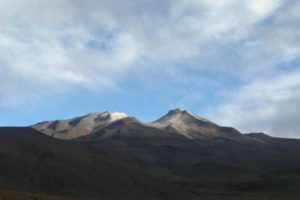
Credit: Jon Blundy
Scientists from the University of Bristol and partner universities in Germany, France, Canada and Wales, have discovered a huge magmatic lake, 15 kilometres below a dormant volcano in Bolivia, South America.
The body of water — which is dissolved into partially molten rock at a temperature of almost 1,000 degrees Celsius — is the equivalent to what is found in some of the world’s giant freshwater lakes, such as Lake Superior.
The find has now led scientists to consider if similar bodies of water may be ‘hiding’ under other volcanoes and could help explain why and how volcanoes erupt.
Professor Jon Blundy, from the School of Earth Sciences, took part in an international multidisciplinary research project at Cerro Uturuncu volcano in the Bolivian Altiplano.
He said: “The Bolivian Altiplano has been the site of extensive volcanism over past 10 million years, although there are no currently active volcanoes there.
“The Altiplano is underlain by a large geophysical anomaly at depths of 15 km below the surface of Earth.
“This anomaly has a volume of one-and-a-half million cubic kilometres or more and is characterised by reduced seismic wave speeds and increased electrical conductivity. This indicates the presence of molten rock.
“The rock is not fully molten, but partially molten. Only about 10 to 20 percent of the rock is actually liquid; the rest is solid. The rock at these depths is at a temperature of about 970°C.”
In order to characterise the partially molten region the team performed high temperature and pressure experiments at the University of Orléans in France.
This measured the electrical conductivity of the molten rock in the ‘anomalous’ region and concluded that there must be about eight to ten percent of water dissolved in the silicate melt.
Professor Blundy added: “This is a large value. It agrees with estimates made for the volcanic rocks of Uturuncu using high temperature and pressure experiments to match the chemical composition of crystals.
“Silicate melt can only dissolve water at high pressure; at lower pressure this water comes out of the solution and forms bubbles. Crucially — these bubbles can drive volcanic eruptions.
“The eight to ten percent of water dissolved in the massive anomaly region amounts to a total mass of water equivalent to what is found in some of the giant freshwater lakes of North America.”
Professor Fabrice Gaillard at University of Orléans explained: “Ten per cent by weight of dissolved water means that there is one molecule of water for every three molecules of silicate. This is an extraordinarily large fraction of water, helping to explain why these silicate liquids are so electrically conductive.”
The researchers hope that better understanding of how water can trigger volcanic eruptions can improve predictions of when it is going to erupt.
Reference:
Mickael Laumonier, Fabrice Gaillard, Duncan Muir, Jon Blundy, Martyn Unsworth. Giant magmatic water reservoirs at mid-crustal depth inferred from electrical conductivity and the growth of the continental crust. Earth and Planetary Science Letters, 2016; DOI: 10.1016/j.epsl.2016.10.023
Note: The above post is reprinted from materials provided by University of Bristol.









